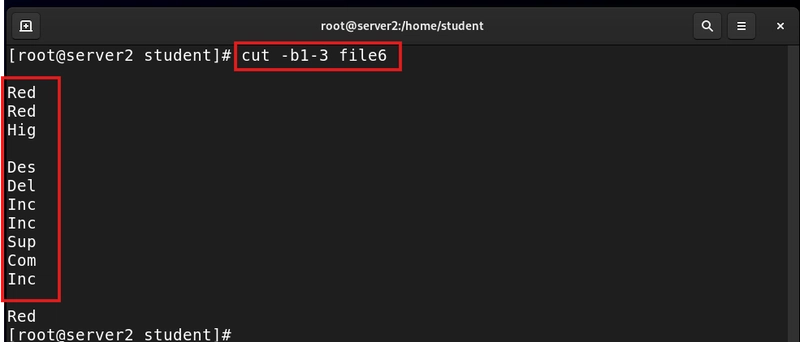Mastering Linux Text Processing Commands: cut, awk, grep, and more
Table of Contents cut: Extracting Specific Parts of a Line awk: Field-Based Processing and Pattern Matching grep & egrep: Pattern Search sort: Sorting Output uniq: Finding Unique Lines wc: Word, Line, and Character Count Conclusion Description Learn how to manipulate, filter, and analyze text in Linux using powerful tools like cut, awk, grep, sort, uniq, and wc — with examples. cut: Extracting Specific Parts of a Line The cut command allows you to extract parts of a line based on character position, byte size, or delimiter. Common cut Examples: Command Description cut --version Check version cut -c1 filename Show only the first character of each line cut -c1,2,4 filename Show characters 1, 2, and 4 cut -c1-3 filename Show a range of characters cut -b1-3 filename Cut by byte size cut -d: -f6 /etc/passwd Show the 6th field, using : as delimiter cut -d: -f6-7 /etc/passwd Show fields 6 and 7 `ls -l cut -c2-4` cut --version cut -c1 file6 cut -c1,2,4 file6 cut -c1-3 file6 cut -b1-3 file6 cut -d: -f6 /etc/passwd cut -d: -f6-7 /etc/passwd ls -l | cut -c1-4 awk: Field-Based Processing and Pattern Matching awk is a powerful text-processing language great for extracting and analyzing structured data. Common awk Examples: Command Description awk --version Check version awk '{print $1}' file Show the first field of each line `ls -l awk '{print $1,$3}'` `ls -l awk '{print $NF}'` awk '/Jerry/ {print}' file Show lines containing "Jerry" awk -F: '{print $1}' /etc/passwd Show the first field using : as delimiter `echo "Hello Tom" awk '{$2="Adam"; print $0}'` awk 'length($0) > 15' file Show lines longer than 15 characters `ls -l awk '{if($9=="seinfeld") print $0;}'` `ls -l awk '{print NF}'` awk --version awk '{print $1}' file6 ls -l | awk '{print $1,$3} grep & egrep: Pattern Search Use grep to search for patterns in text files. Command Description grep 'error' logfile.txt Search for "error" in a file `egrep 'warn fail' logfile.txt` grep -i 'login' file Case-insensitive search grep -v 'debug' file Exclude lines with "debug" grep -r 'main' /etc/ Recursively search through directories grep 'error' logfile.txt egrep 'warn|fail' logfile.txt grep -v 'fail' logfile.txt grep -r 'main' /etc/ sort: Sorting Output Sort lines in alphabetical or numerical order. Command Description sort file.txt Sort file alphabetically sort -r file.txt Reverse sort sort -n numbers.txt Sort numerically sort -u file.txt Remove duplicates after sorting uniq: Finding Unique Lines Filters repeated lines. Often used with sort. Command Description uniq file.txt Show unique lines (removes duplicates) `sort file.txt uniq` uniq -c file.txt Count occurrences of each line wc: Word, Line, and Character Count wc stands for word count and can be used for multiple metrics. Command Description wc -l file.txt Count lines wc -w file.txt Count words wc -c file.txt Count characters (bytes) `cat file.txt wc` wc logfile.txt wc -w logfile.txt wc -c logfile.txt cat logfile.txt | wc Conclusion These commands are the backbone of text processing and data filtering on the Linux command line. Whether you're working with logs, config files, or large datasets, knowing how to combine and use cut, awk, grep, sort, uniq, and wc will make your life a lot easier.

Table of Contents
- cut: Extracting Specific Parts of a Line
- awk: Field-Based Processing and Pattern Matching
- grep & egrep: Pattern Search
- sort: Sorting Output
- uniq: Finding Unique Lines
- wc: Word, Line, and Character Count
- Conclusion
Description
Learn how to manipulate, filter, and analyze text in Linux using powerful tools like cut, awk, grep, sort, uniq, and wc — with examples.
cut: Extracting Specific Parts of a Line
The cut command allows you to extract parts of a line based on character position, byte size, or delimiter.
Common cut Examples:
| Command | Description |
|---|---|
cut --version |
Check version |
cut -c1 filename |
Show only the first character of each line |
cut -c1,2,4 filename |
Show characters 1, 2, and 4 |
cut -c1-3 filename |
Show a range of characters |
cut -b1-3 filename |
Cut by byte size |
cut -d: -f6 /etc/passwd |
Show the 6th field, using : as delimiter |
cut -d: -f6-7 /etc/passwd |
Show fields 6 and 7 |
| `ls -l | cut -c2-4` |
-
cut --version
-
cut -c1 file6
-
cut -c1,2,4 file6
-
cut -c1-3 file6
-
cut -b1-3 file6
-
cut -d: -f6 /etc/passwd
-
cut -d: -f6-7 /etc/passwd
-
ls -l | cut -c1-4
awk: Field-Based Processing and Pattern Matching
awk is a powerful text-processing language great for extracting and analyzing structured data.
Common awk Examples:
| Command | Description |
|---|---|
awk --version |
Check version |
awk '{print $1}' file |
Show the first field of each line |
| `ls -l | awk '{print $1,$3}'` |
| `ls -l | awk '{print $NF}'` |
awk '/Jerry/ {print}' file |
Show lines containing "Jerry" |
awk -F: '{print $1}' /etc/passwd |
Show the first field using : as delimiter |
| `echo "Hello Tom" | awk '{$2="Adam"; print $0}'` |
awk 'length($0) > 15' file |
Show lines longer than 15 characters |
| `ls -l | awk '{if($9=="seinfeld") print $0;}'` |
| `ls -l | awk '{print NF}'` |
-
awk --version
-
awk '{print $1}' file6
-
ls -l | awk '{print $1,$3}
grep & egrep: Pattern Search
Use grep to search for patterns in text files.
| Command | Description |
|---|---|
grep 'error' logfile.txt |
Search for "error" in a file |
| `egrep 'warn | fail' logfile.txt` |
grep -i 'login' file |
Case-insensitive search |
grep -v 'debug' file |
Exclude lines with "debug" |
grep -r 'main' /etc/ |
Recursively search through directories |
-
grep 'error' logfile.txt
-
egrep 'warn|fail' logfile.txt
-
grep -v 'fail' logfile.txt
-
grep -r 'main' /etc/
sort: Sorting Output
Sort lines in alphabetical or numerical order.
| Command | Description |
|---|---|
sort file.txt |
Sort file alphabetically |
sort -r file.txt |
Reverse sort |
sort -n numbers.txt |
Sort numerically |
sort -u file.txt |
Remove duplicates after sorting |
uniq: Finding Unique Lines
Filters repeated lines. Often used with sort.
| Command | Description |
|---|---|
uniq file.txt |
Show unique lines (removes duplicates) |
| `sort file.txt | uniq` |
uniq -c file.txt |
Count occurrences of each line |
wc: Word, Line, and Character Count
wc stands for word count and can be used for multiple metrics.
| Command | Description |
|---|---|
wc -l file.txt |
Count lines |
wc -w file.txt |
Count words |
wc -c file.txt |
Count characters (bytes) |
| `cat file.txt | wc` |
-
wc logfile.txt
-
wc -w logfile.txt
-
wc -c logfile.txt
-
cat logfile.txt | wc
Conclusion
These commands are the backbone of text processing and data filtering on the Linux command line. Whether you're working with logs, config files, or large datasets, knowing how to combine and use cut, awk, grep, sort, uniq, and wc will make your life a lot easier.






































































































































































![[The AI Show Episode 145]: OpenAI Releases o3 and o4-mini, AI Is Causing “Quiet Layoffs,” Executive Order on Youth AI Education & GPT-4o’s Controversial Update](https://www.marketingaiinstitute.com/hubfs/ep%20145%20cover.png)
















































































































































































































































































 Stolen 884,000 Credit Card Details on 13 Million Clicks from Users Worldwide.webp?#)




























































































![Chrome 136 tones down some Dynamic Color on Android [U]](https://i0.wp.com/9to5google.com/wp-content/uploads/sites/4/2023/03/google-chrome-logo-4.jpg?resize=1200%2C628&quality=82&strip=all&ssl=1)















![Apple Shares Official Teaser for 'Highest 2 Lowest' Starring Denzel Washington [Video]](https://www.iclarified.com/images/news/97221/97221/97221-640.jpg)

![Under-Display Face ID Coming to iPhone 18 Pro and Pro Max [Rumor]](https://www.iclarified.com/images/news/97215/97215/97215-640.jpg)

































































































